Implementation of Warehouse Management System for Business Growth
VerifiedAdded on 2021/06/17
|15
|3141
|23
Report
AI Summary
This report details the implementation of a Warehouse Management System (WMS) to improve business performance, focusing on the case of Jewel Fine Foods. It outlines project objectives, scope, and a comprehensive literature review, examining WMS's impact on inventory management and order fulfillment. The report explores research questions, including the effective implementation of WMS and its effects on an organization. The methodology includes qualitative and quantitative research methods, data collection, and analysis techniques. The report also discusses the implementation process, productivity tools like barcodes, and justification for WMS implementation. The conclusion summarizes the key findings and implications of the study.
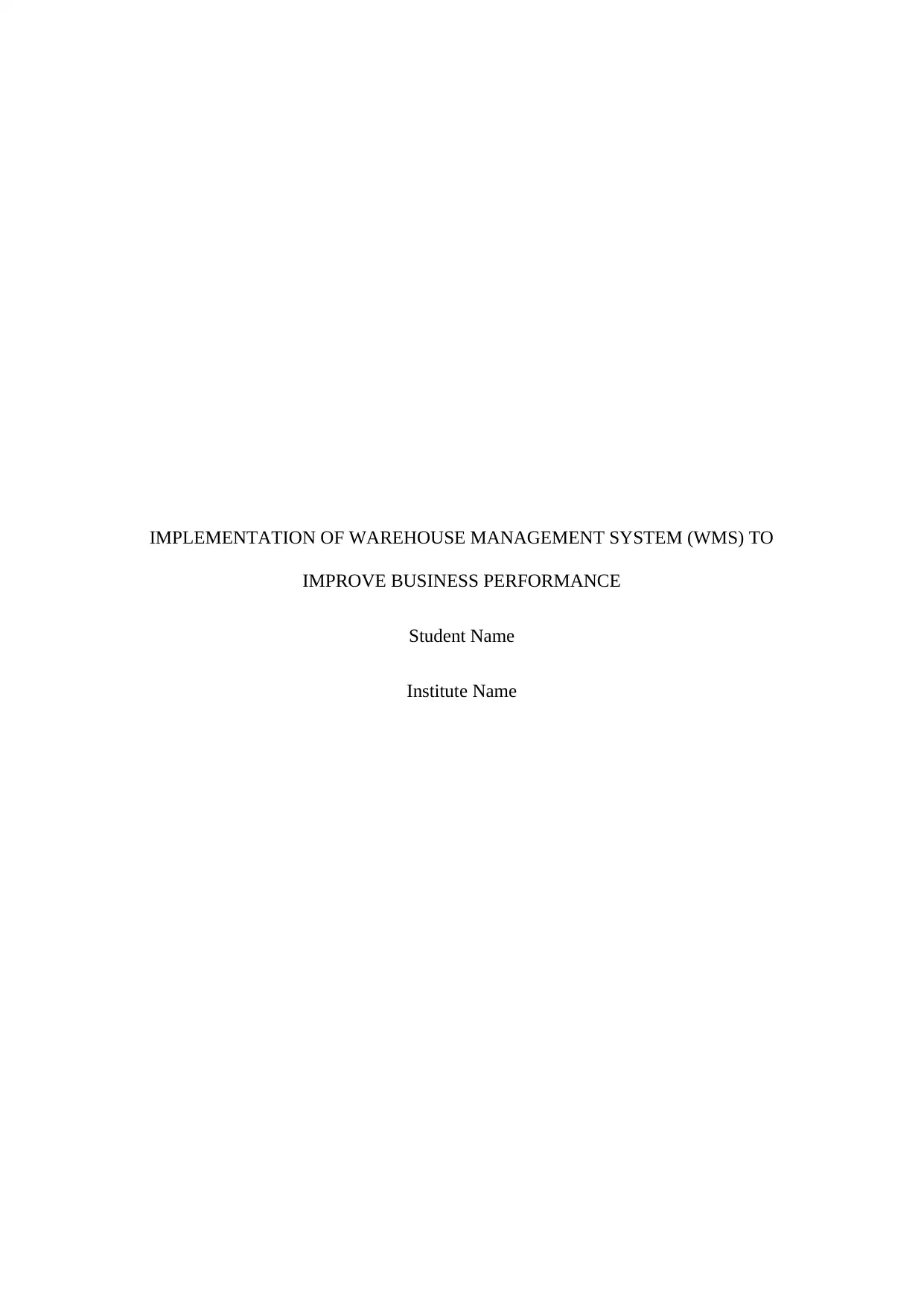
IMPLEMENTATION OF WAREHOUSE MANAGEMENT SYSTEM (WMS) TO
IMPROVE BUSINESS PERFORMANCE
Student Name
Institute Name
IMPROVE BUSINESS PERFORMANCE
Student Name
Institute Name
Paraphrase This Document
Need a fresh take? Get an instant paraphrase of this document with our AI Paraphraser
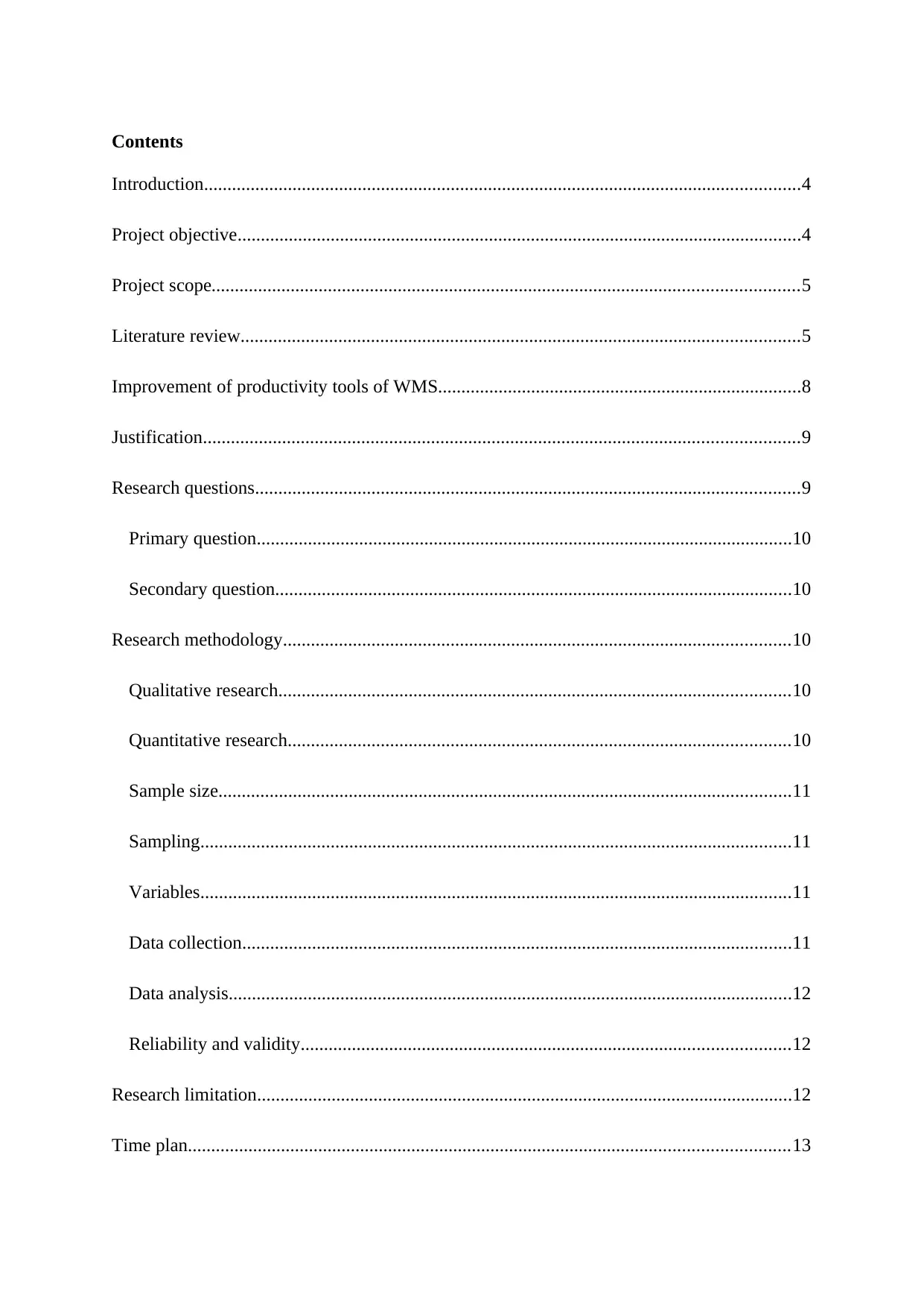
Contents
Introduction................................................................................................................................4
Project objective.........................................................................................................................4
Project scope..............................................................................................................................5
Literature review........................................................................................................................5
Improvement of productivity tools of WMS..............................................................................8
Justification................................................................................................................................9
Research questions.....................................................................................................................9
Primary question...................................................................................................................10
Secondary question...............................................................................................................10
Research methodology.............................................................................................................10
Qualitative research..............................................................................................................10
Quantitative research............................................................................................................10
Sample size...........................................................................................................................11
Sampling...............................................................................................................................11
Variables...............................................................................................................................11
Data collection......................................................................................................................11
Data analysis.........................................................................................................................12
Reliability and validity.........................................................................................................12
Research limitation...................................................................................................................12
Time plan.................................................................................................................................13
Introduction................................................................................................................................4
Project objective.........................................................................................................................4
Project scope..............................................................................................................................5
Literature review........................................................................................................................5
Improvement of productivity tools of WMS..............................................................................8
Justification................................................................................................................................9
Research questions.....................................................................................................................9
Primary question...................................................................................................................10
Secondary question...............................................................................................................10
Research methodology.............................................................................................................10
Qualitative research..............................................................................................................10
Quantitative research............................................................................................................10
Sample size...........................................................................................................................11
Sampling...............................................................................................................................11
Variables...............................................................................................................................11
Data collection......................................................................................................................11
Data analysis.........................................................................................................................12
Reliability and validity.........................................................................................................12
Research limitation...................................................................................................................12
Time plan.................................................................................................................................13

Conclusion…………………………………………………………………………………. 13
Reference..................................................................................................................................14
Reference..................................................................................................................................14
⊘ This is a preview!⊘
Do you want full access?
Subscribe today to unlock all pages.

Trusted by 1+ million students worldwide
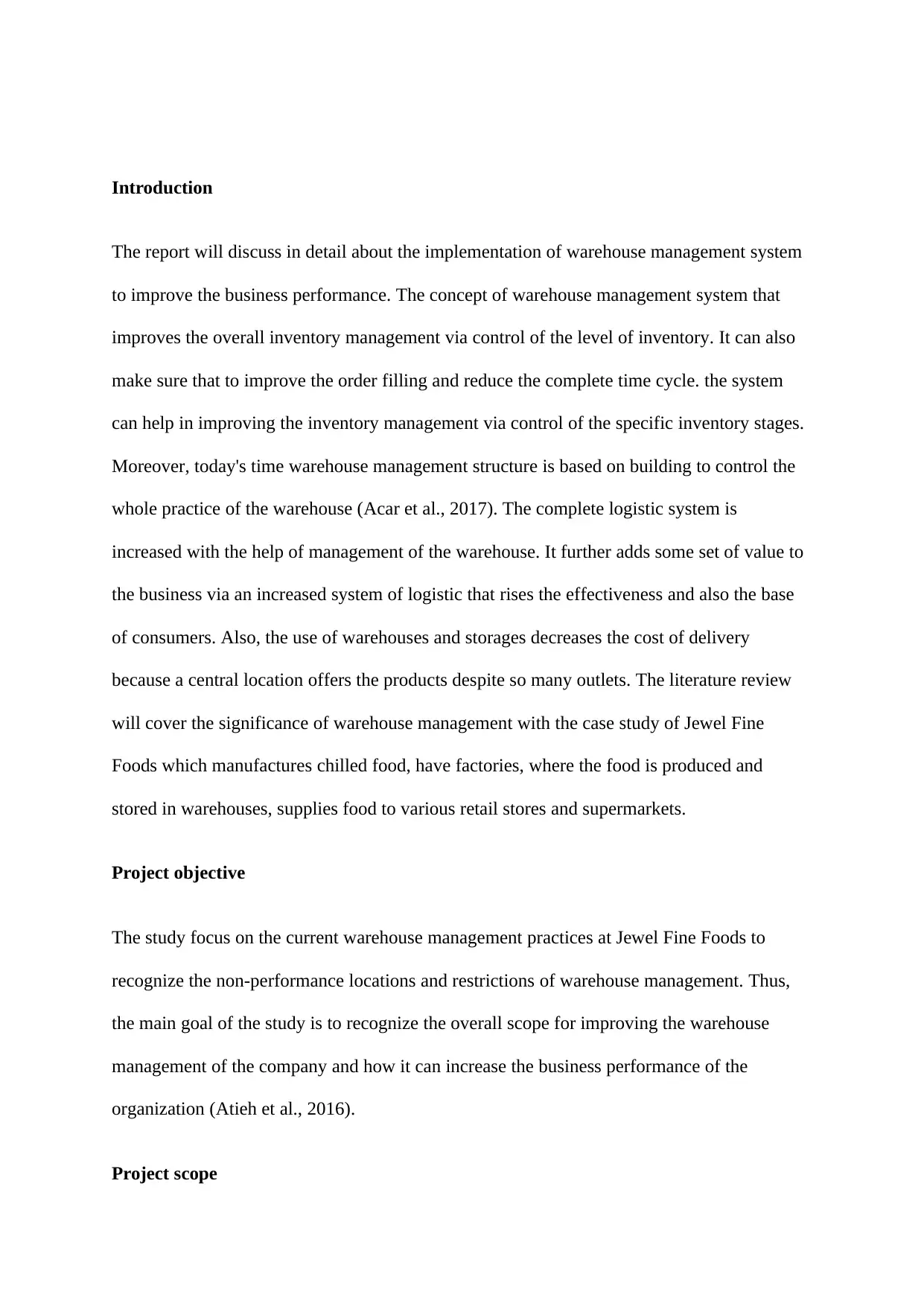
Introduction
The report will discuss in detail about the implementation of warehouse management system
to improve the business performance. The concept of warehouse management system that
improves the overall inventory management via control of the level of inventory. It can also
make sure that to improve the order filling and reduce the complete time cycle. the system
can help in improving the inventory management via control of the specific inventory stages.
Moreover, today's time warehouse management structure is based on building to control the
whole practice of the warehouse (Acar et al., 2017). The complete logistic system is
increased with the help of management of the warehouse. It further adds some set of value to
the business via an increased system of logistic that rises the effectiveness and also the base
of consumers. Also, the use of warehouses and storages decreases the cost of delivery
because a central location offers the products despite so many outlets. The literature review
will cover the significance of warehouse management with the case study of Jewel Fine
Foods which manufactures chilled food, have factories, where the food is produced and
stored in warehouses, supplies food to various retail stores and supermarkets.
Project objective
The study focus on the current warehouse management practices at Jewel Fine Foods to
recognize the non-performance locations and restrictions of warehouse management. Thus,
the main goal of the study is to recognize the overall scope for improving the warehouse
management of the company and how it can increase the business performance of the
organization (Atieh et al., 2016).
Project scope
The report will discuss in detail about the implementation of warehouse management system
to improve the business performance. The concept of warehouse management system that
improves the overall inventory management via control of the level of inventory. It can also
make sure that to improve the order filling and reduce the complete time cycle. the system
can help in improving the inventory management via control of the specific inventory stages.
Moreover, today's time warehouse management structure is based on building to control the
whole practice of the warehouse (Acar et al., 2017). The complete logistic system is
increased with the help of management of the warehouse. It further adds some set of value to
the business via an increased system of logistic that rises the effectiveness and also the base
of consumers. Also, the use of warehouses and storages decreases the cost of delivery
because a central location offers the products despite so many outlets. The literature review
will cover the significance of warehouse management with the case study of Jewel Fine
Foods which manufactures chilled food, have factories, where the food is produced and
stored in warehouses, supplies food to various retail stores and supermarkets.
Project objective
The study focus on the current warehouse management practices at Jewel Fine Foods to
recognize the non-performance locations and restrictions of warehouse management. Thus,
the main goal of the study is to recognize the overall scope for improving the warehouse
management of the company and how it can increase the business performance of the
organization (Atieh et al., 2016).
Project scope
Paraphrase This Document
Need a fresh take? Get an instant paraphrase of this document with our AI Paraphraser
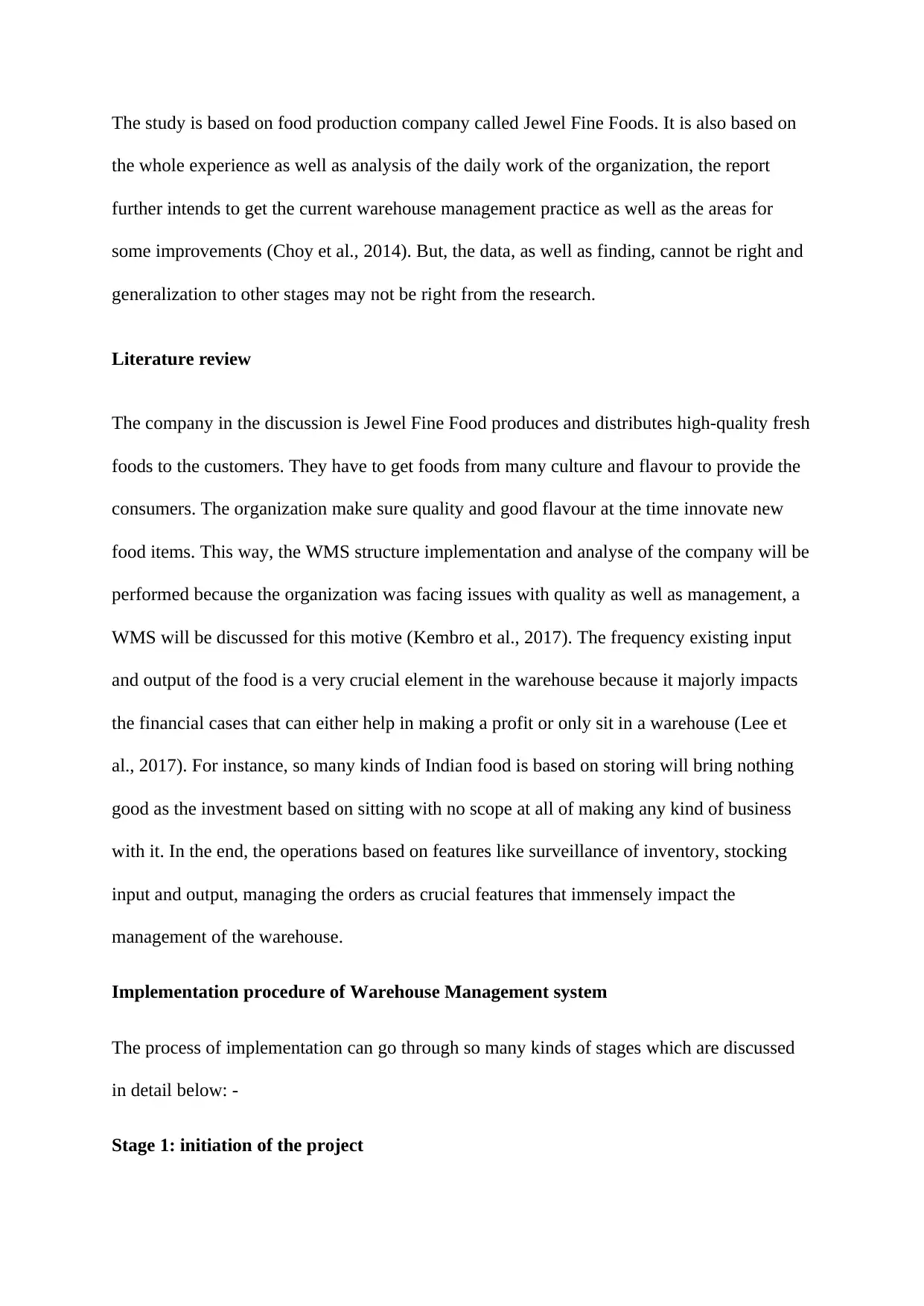
The study is based on food production company called Jewel Fine Foods. It is also based on
the whole experience as well as analysis of the daily work of the organization, the report
further intends to get the current warehouse management practice as well as the areas for
some improvements (Choy et al., 2014). But, the data, as well as finding, cannot be right and
generalization to other stages may not be right from the research.
Literature review
The company in the discussion is Jewel Fine Food produces and distributes high-quality fresh
foods to the customers. They have to get foods from many culture and flavour to provide the
consumers. The organization make sure quality and good flavour at the time innovate new
food items. This way, the WMS structure implementation and analyse of the company will be
performed because the organization was facing issues with quality as well as management, a
WMS will be discussed for this motive (Kembro et al., 2017). The frequency existing input
and output of the food is a very crucial element in the warehouse because it majorly impacts
the financial cases that can either help in making a profit or only sit in a warehouse (Lee et
al., 2017). For instance, so many kinds of Indian food is based on storing will bring nothing
good as the investment based on sitting with no scope at all of making any kind of business
with it. In the end, the operations based on features like surveillance of inventory, stocking
input and output, managing the orders as crucial features that immensely impact the
management of the warehouse.
Implementation procedure of Warehouse Management system
The process of implementation can go through so many kinds of stages which are discussed
in detail below: -
Stage 1: initiation of the project
the whole experience as well as analysis of the daily work of the organization, the report
further intends to get the current warehouse management practice as well as the areas for
some improvements (Choy et al., 2014). But, the data, as well as finding, cannot be right and
generalization to other stages may not be right from the research.
Literature review
The company in the discussion is Jewel Fine Food produces and distributes high-quality fresh
foods to the customers. They have to get foods from many culture and flavour to provide the
consumers. The organization make sure quality and good flavour at the time innovate new
food items. This way, the WMS structure implementation and analyse of the company will be
performed because the organization was facing issues with quality as well as management, a
WMS will be discussed for this motive (Kembro et al., 2017). The frequency existing input
and output of the food is a very crucial element in the warehouse because it majorly impacts
the financial cases that can either help in making a profit or only sit in a warehouse (Lee et
al., 2017). For instance, so many kinds of Indian food is based on storing will bring nothing
good as the investment based on sitting with no scope at all of making any kind of business
with it. In the end, the operations based on features like surveillance of inventory, stocking
input and output, managing the orders as crucial features that immensely impact the
management of the warehouse.
Implementation procedure of Warehouse Management system
The process of implementation can go through so many kinds of stages which are discussed
in detail below: -
Stage 1: initiation of the project
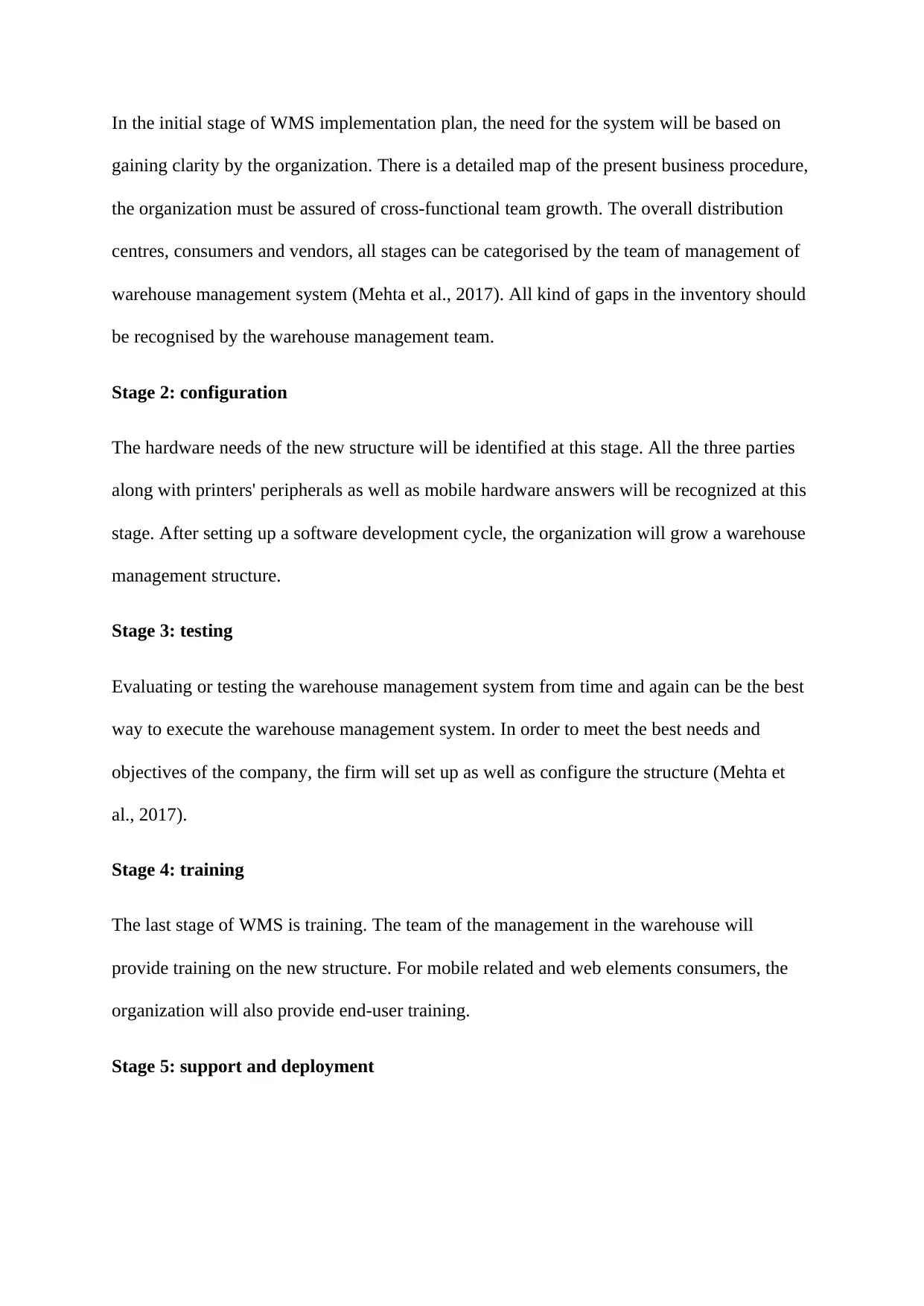
In the initial stage of WMS implementation plan, the need for the system will be based on
gaining clarity by the organization. There is a detailed map of the present business procedure,
the organization must be assured of cross-functional team growth. The overall distribution
centres, consumers and vendors, all stages can be categorised by the team of management of
warehouse management system (Mehta et al., 2017). All kind of gaps in the inventory should
be recognised by the warehouse management team.
Stage 2: configuration
The hardware needs of the new structure will be identified at this stage. All the three parties
along with printers' peripherals as well as mobile hardware answers will be recognized at this
stage. After setting up a software development cycle, the organization will grow a warehouse
management structure.
Stage 3: testing
Evaluating or testing the warehouse management system from time and again can be the best
way to execute the warehouse management system. In order to meet the best needs and
objectives of the company, the firm will set up as well as configure the structure (Mehta et
al., 2017).
Stage 4: training
The last stage of WMS is training. The team of the management in the warehouse will
provide training on the new structure. For mobile related and web elements consumers, the
organization will also provide end-user training.
Stage 5: support and deployment
gaining clarity by the organization. There is a detailed map of the present business procedure,
the organization must be assured of cross-functional team growth. The overall distribution
centres, consumers and vendors, all stages can be categorised by the team of management of
warehouse management system (Mehta et al., 2017). All kind of gaps in the inventory should
be recognised by the warehouse management team.
Stage 2: configuration
The hardware needs of the new structure will be identified at this stage. All the three parties
along with printers' peripherals as well as mobile hardware answers will be recognized at this
stage. After setting up a software development cycle, the organization will grow a warehouse
management structure.
Stage 3: testing
Evaluating or testing the warehouse management system from time and again can be the best
way to execute the warehouse management system. In order to meet the best needs and
objectives of the company, the firm will set up as well as configure the structure (Mehta et
al., 2017).
Stage 4: training
The last stage of WMS is training. The team of the management in the warehouse will
provide training on the new structure. For mobile related and web elements consumers, the
organization will also provide end-user training.
Stage 5: support and deployment
⊘ This is a preview!⊘
Do you want full access?
Subscribe today to unlock all pages.

Trusted by 1+ million students worldwide
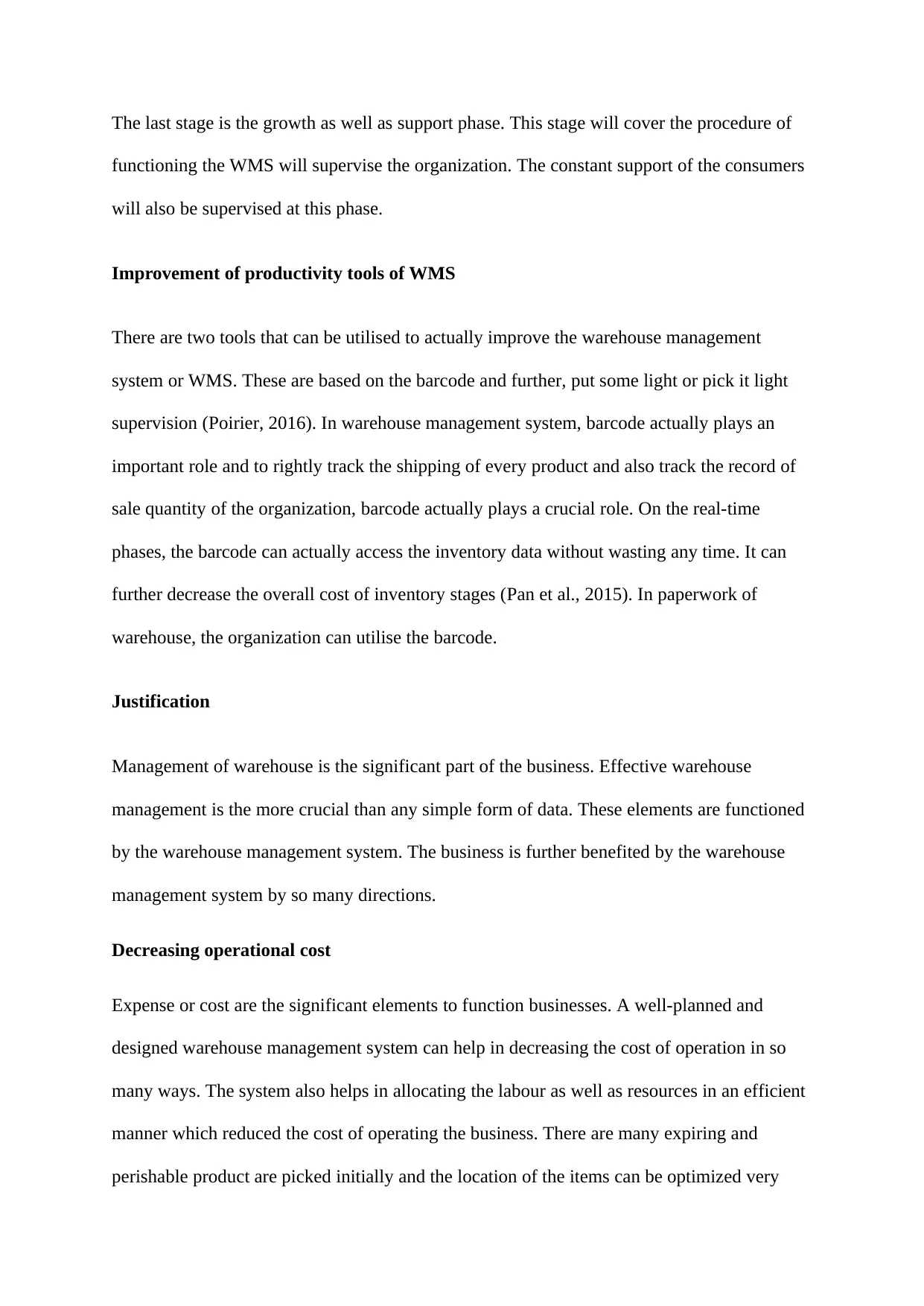
The last stage is the growth as well as support phase. This stage will cover the procedure of
functioning the WMS will supervise the organization. The constant support of the consumers
will also be supervised at this phase.
Improvement of productivity tools of WMS
There are two tools that can be utilised to actually improve the warehouse management
system or WMS. These are based on the barcode and further, put some light or pick it light
supervision (Poirier, 2016). In warehouse management system, barcode actually plays an
important role and to rightly track the shipping of every product and also track the record of
sale quantity of the organization, barcode actually plays a crucial role. On the real-time
phases, the barcode can actually access the inventory data without wasting any time. It can
further decrease the overall cost of inventory stages (Pan et al., 2015). In paperwork of
warehouse, the organization can utilise the barcode.
Justification
Management of warehouse is the significant part of the business. Effective warehouse
management is the more crucial than any simple form of data. These elements are functioned
by the warehouse management system. The business is further benefited by the warehouse
management system by so many directions.
Decreasing operational cost
Expense or cost are the significant elements to function businesses. A well-planned and
designed warehouse management system can help in decreasing the cost of operation in so
many ways. The system also helps in allocating the labour as well as resources in an efficient
manner which reduced the cost of operating the business. There are many expiring and
perishable product are picked initially and the location of the items can be optimized very
functioning the WMS will supervise the organization. The constant support of the consumers
will also be supervised at this phase.
Improvement of productivity tools of WMS
There are two tools that can be utilised to actually improve the warehouse management
system or WMS. These are based on the barcode and further, put some light or pick it light
supervision (Poirier, 2016). In warehouse management system, barcode actually plays an
important role and to rightly track the shipping of every product and also track the record of
sale quantity of the organization, barcode actually plays a crucial role. On the real-time
phases, the barcode can actually access the inventory data without wasting any time. It can
further decrease the overall cost of inventory stages (Pan et al., 2015). In paperwork of
warehouse, the organization can utilise the barcode.
Justification
Management of warehouse is the significant part of the business. Effective warehouse
management is the more crucial than any simple form of data. These elements are functioned
by the warehouse management system. The business is further benefited by the warehouse
management system by so many directions.
Decreasing operational cost
Expense or cost are the significant elements to function businesses. A well-planned and
designed warehouse management system can help in decreasing the cost of operation in so
many ways. The system also helps in allocating the labour as well as resources in an efficient
manner which reduced the cost of operating the business. There are many expiring and
perishable product are picked initially and the location of the items can be optimized very
Paraphrase This Document
Need a fresh take? Get an instant paraphrase of this document with our AI Paraphraser
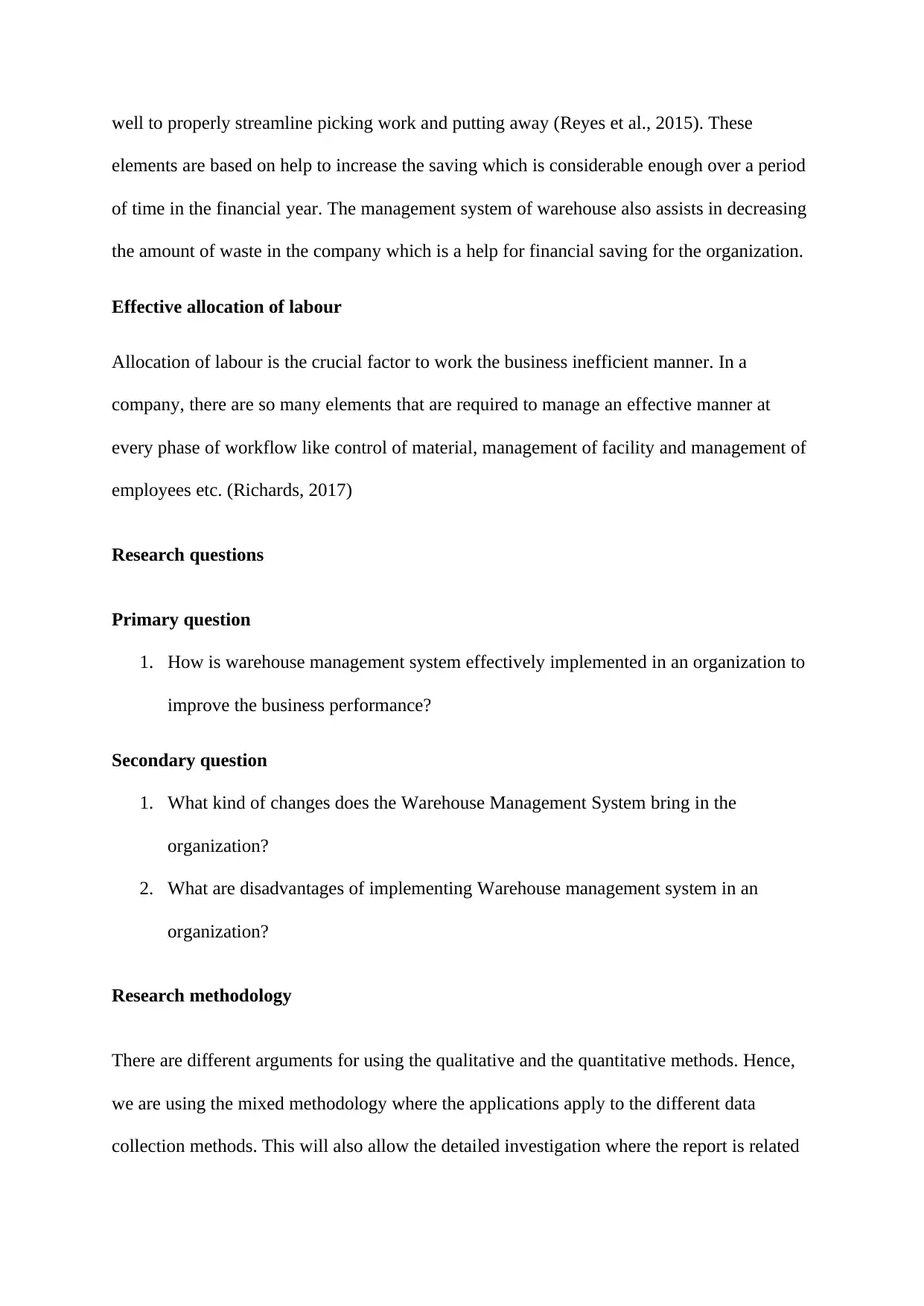
well to properly streamline picking work and putting away (Reyes et al., 2015). These
elements are based on help to increase the saving which is considerable enough over a period
of time in the financial year. The management system of warehouse also assists in decreasing
the amount of waste in the company which is a help for financial saving for the organization.
Effective allocation of labour
Allocation of labour is the crucial factor to work the business inefficient manner. In a
company, there are so many elements that are required to manage an effective manner at
every phase of workflow like control of material, management of facility and management of
employees etc. (Richards, 2017)
Research questions
Primary question
1. How is warehouse management system effectively implemented in an organization to
improve the business performance?
Secondary question
1. What kind of changes does the Warehouse Management System bring in the
organization?
2. What are disadvantages of implementing Warehouse management system in an
organization?
Research methodology
There are different arguments for using the qualitative and the quantitative methods. Hence,
we are using the mixed methodology where the applications apply to the different data
collection methods. This will also allow the detailed investigation where the report is related
elements are based on help to increase the saving which is considerable enough over a period
of time in the financial year. The management system of warehouse also assists in decreasing
the amount of waste in the company which is a help for financial saving for the organization.
Effective allocation of labour
Allocation of labour is the crucial factor to work the business inefficient manner. In a
company, there are so many elements that are required to manage an effective manner at
every phase of workflow like control of material, management of facility and management of
employees etc. (Richards, 2017)
Research questions
Primary question
1. How is warehouse management system effectively implemented in an organization to
improve the business performance?
Secondary question
1. What kind of changes does the Warehouse Management System bring in the
organization?
2. What are disadvantages of implementing Warehouse management system in an
organization?
Research methodology
There are different arguments for using the qualitative and the quantitative methods. Hence,
we are using the mixed methodology where the applications apply to the different data
collection methods. This will also allow the detailed investigation where the report is related
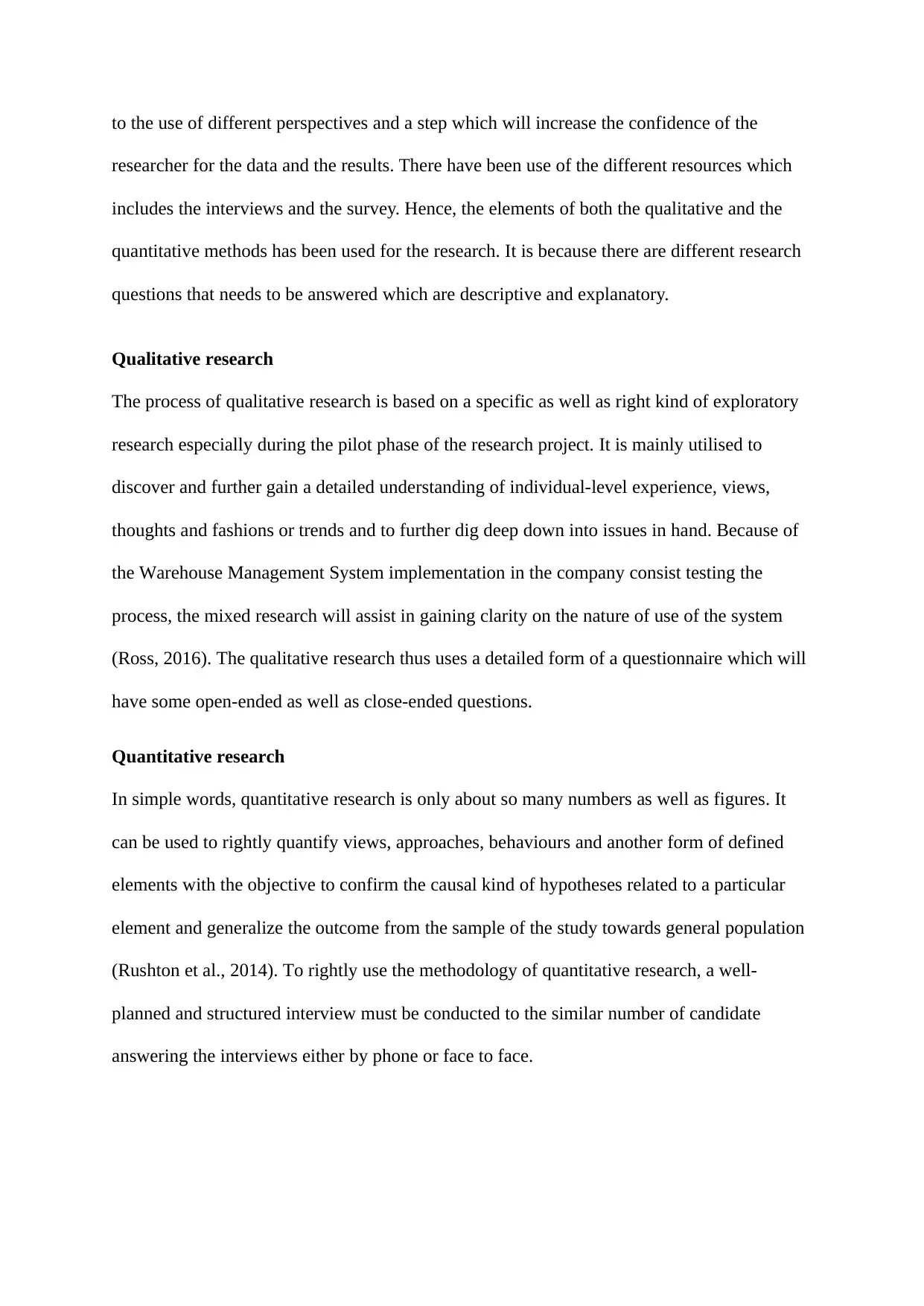
to the use of different perspectives and a step which will increase the confidence of the
researcher for the data and the results. There have been use of the different resources which
includes the interviews and the survey. Hence, the elements of both the qualitative and the
quantitative methods has been used for the research. It is because there are different research
questions that needs to be answered which are descriptive and explanatory.
Qualitative research
The process of qualitative research is based on a specific as well as right kind of exploratory
research especially during the pilot phase of the research project. It is mainly utilised to
discover and further gain a detailed understanding of individual-level experience, views,
thoughts and fashions or trends and to further dig deep down into issues in hand. Because of
the Warehouse Management System implementation in the company consist testing the
process, the mixed research will assist in gaining clarity on the nature of use of the system
(Ross, 2016). The qualitative research thus uses a detailed form of a questionnaire which will
have some open-ended as well as close-ended questions.
Quantitative research
In simple words, quantitative research is only about so many numbers as well as figures. It
can be used to rightly quantify views, approaches, behaviours and another form of defined
elements with the objective to confirm the causal kind of hypotheses related to a particular
element and generalize the outcome from the sample of the study towards general population
(Rushton et al., 2014). To rightly use the methodology of quantitative research, a well-
planned and structured interview must be conducted to the similar number of candidate
answering the interviews either by phone or face to face.
researcher for the data and the results. There have been use of the different resources which
includes the interviews and the survey. Hence, the elements of both the qualitative and the
quantitative methods has been used for the research. It is because there are different research
questions that needs to be answered which are descriptive and explanatory.
Qualitative research
The process of qualitative research is based on a specific as well as right kind of exploratory
research especially during the pilot phase of the research project. It is mainly utilised to
discover and further gain a detailed understanding of individual-level experience, views,
thoughts and fashions or trends and to further dig deep down into issues in hand. Because of
the Warehouse Management System implementation in the company consist testing the
process, the mixed research will assist in gaining clarity on the nature of use of the system
(Ross, 2016). The qualitative research thus uses a detailed form of a questionnaire which will
have some open-ended as well as close-ended questions.
Quantitative research
In simple words, quantitative research is only about so many numbers as well as figures. It
can be used to rightly quantify views, approaches, behaviours and another form of defined
elements with the objective to confirm the causal kind of hypotheses related to a particular
element and generalize the outcome from the sample of the study towards general population
(Rushton et al., 2014). To rightly use the methodology of quantitative research, a well-
planned and structured interview must be conducted to the similar number of candidate
answering the interviews either by phone or face to face.
⊘ This is a preview!⊘
Do you want full access?
Subscribe today to unlock all pages.

Trusted by 1+ million students worldwide
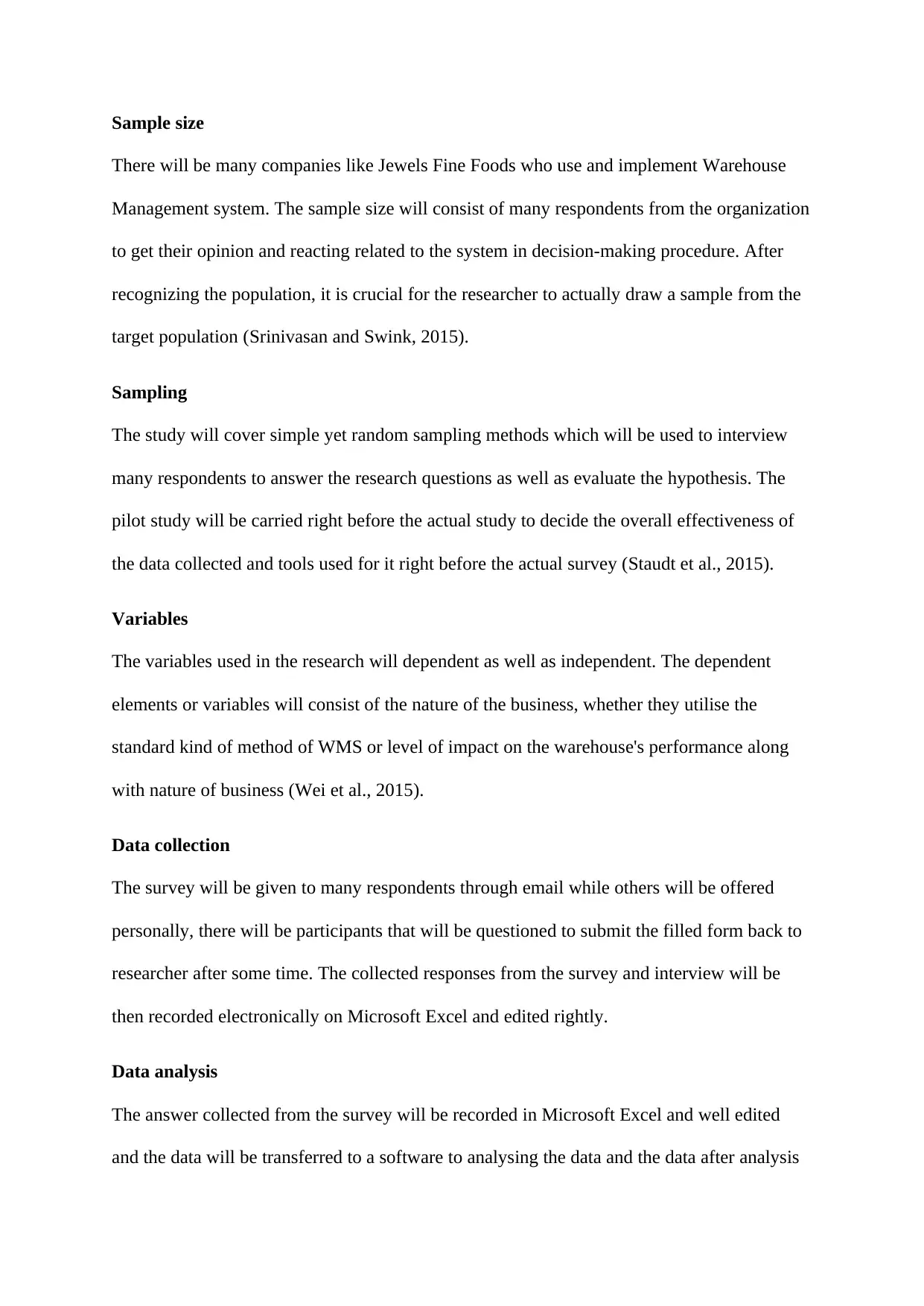
Sample size
There will be many companies like Jewels Fine Foods who use and implement Warehouse
Management system. The sample size will consist of many respondents from the organization
to get their opinion and reacting related to the system in decision-making procedure. After
recognizing the population, it is crucial for the researcher to actually draw a sample from the
target population (Srinivasan and Swink, 2015).
Sampling
The study will cover simple yet random sampling methods which will be used to interview
many respondents to answer the research questions as well as evaluate the hypothesis. The
pilot study will be carried right before the actual study to decide the overall effectiveness of
the data collected and tools used for it right before the actual survey (Staudt et al., 2015).
Variables
The variables used in the research will dependent as well as independent. The dependent
elements or variables will consist of the nature of the business, whether they utilise the
standard kind of method of WMS or level of impact on the warehouse's performance along
with nature of business (Wei et al., 2015).
Data collection
The survey will be given to many respondents through email while others will be offered
personally, there will be participants that will be questioned to submit the filled form back to
researcher after some time. The collected responses from the survey and interview will be
then recorded electronically on Microsoft Excel and edited rightly.
Data analysis
The answer collected from the survey will be recorded in Microsoft Excel and well edited
and the data will be transferred to a software to analysing the data and the data after analysis
There will be many companies like Jewels Fine Foods who use and implement Warehouse
Management system. The sample size will consist of many respondents from the organization
to get their opinion and reacting related to the system in decision-making procedure. After
recognizing the population, it is crucial for the researcher to actually draw a sample from the
target population (Srinivasan and Swink, 2015).
Sampling
The study will cover simple yet random sampling methods which will be used to interview
many respondents to answer the research questions as well as evaluate the hypothesis. The
pilot study will be carried right before the actual study to decide the overall effectiveness of
the data collected and tools used for it right before the actual survey (Staudt et al., 2015).
Variables
The variables used in the research will dependent as well as independent. The dependent
elements or variables will consist of the nature of the business, whether they utilise the
standard kind of method of WMS or level of impact on the warehouse's performance along
with nature of business (Wei et al., 2015).
Data collection
The survey will be given to many respondents through email while others will be offered
personally, there will be participants that will be questioned to submit the filled form back to
researcher after some time. The collected responses from the survey and interview will be
then recorded electronically on Microsoft Excel and edited rightly.
Data analysis
The answer collected from the survey will be recorded in Microsoft Excel and well edited
and the data will be transferred to a software to analysing the data and the data after analysis
Paraphrase This Document
Need a fresh take? Get an instant paraphrase of this document with our AI Paraphraser
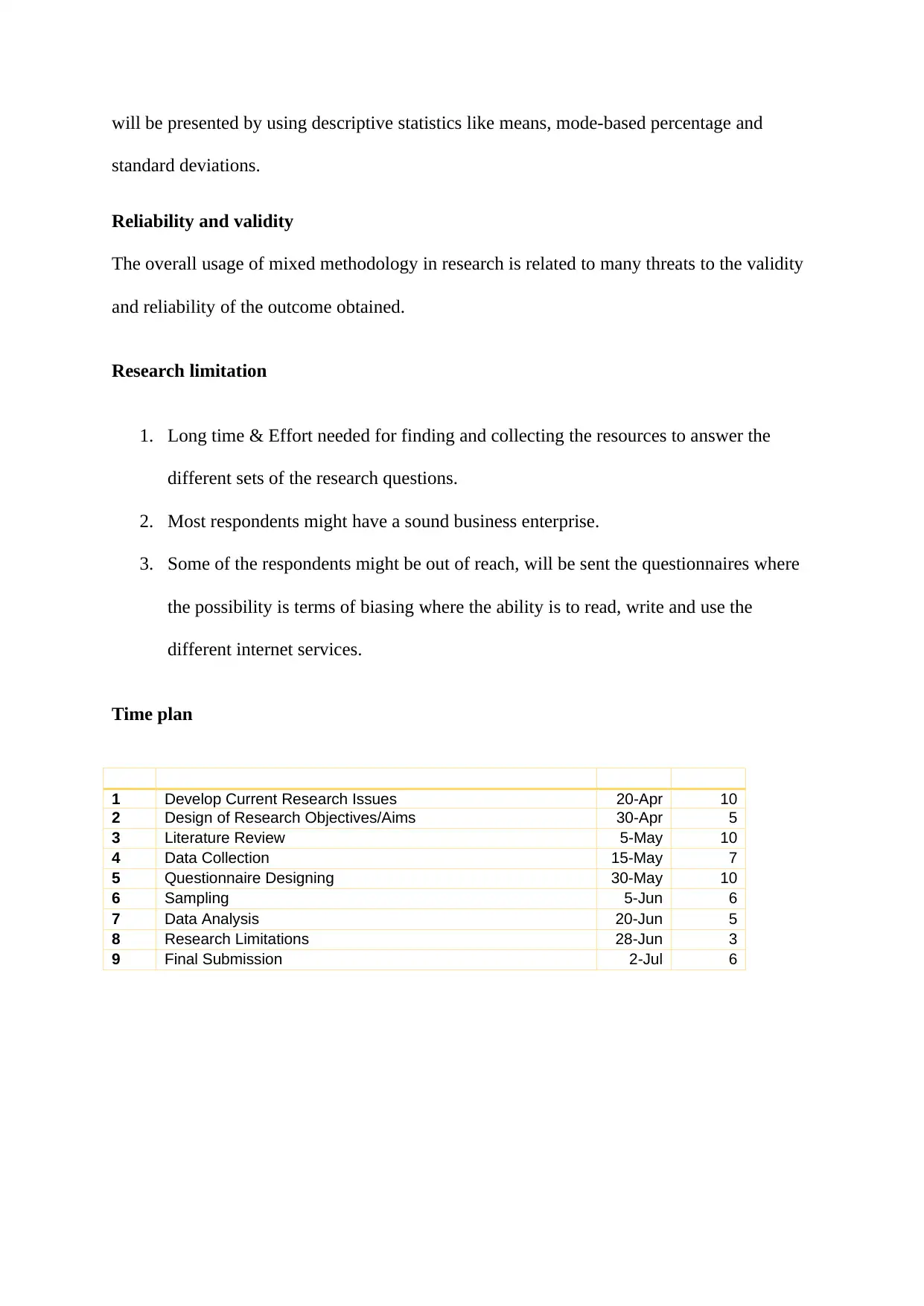
will be presented by using descriptive statistics like means, mode-based percentage and
standard deviations.
Reliability and validity
The overall usage of mixed methodology in research is related to many threats to the validity
and reliability of the outcome obtained.
Research limitation
1. Long time & Effort needed for finding and collecting the resources to answer the
different sets of the research questions.
2. Most respondents might have a sound business enterprise.
3. Some of the respondents might be out of reach, will be sent the questionnaires where
the possibility is terms of biasing where the ability is to read, write and use the
different internet services.
Time plan
1 Develop Current Research Issues 20-Apr 10
2 Design of Research Objectives/Aims 30-Apr 5
3 Literature Review 5-May 10
4 Data Collection 15-May 7
5 Questionnaire Designing 30-May 10
6 Sampling 5-Jun 6
7 Data Analysis 20-Jun 5
8 Research Limitations 28-Jun 3
9 Final Submission 2-Jul 6
standard deviations.
Reliability and validity
The overall usage of mixed methodology in research is related to many threats to the validity
and reliability of the outcome obtained.
Research limitation
1. Long time & Effort needed for finding and collecting the resources to answer the
different sets of the research questions.
2. Most respondents might have a sound business enterprise.
3. Some of the respondents might be out of reach, will be sent the questionnaires where
the possibility is terms of biasing where the ability is to read, write and use the
different internet services.
Time plan
1 Develop Current Research Issues 20-Apr 10
2 Design of Research Objectives/Aims 30-Apr 5
3 Literature Review 5-May 10
4 Data Collection 15-May 7
5 Questionnaire Designing 30-May 10
6 Sampling 5-Jun 6
7 Data Analysis 20-Jun 5
8 Research Limitations 28-Jun 3
9 Final Submission 2-Jul 6
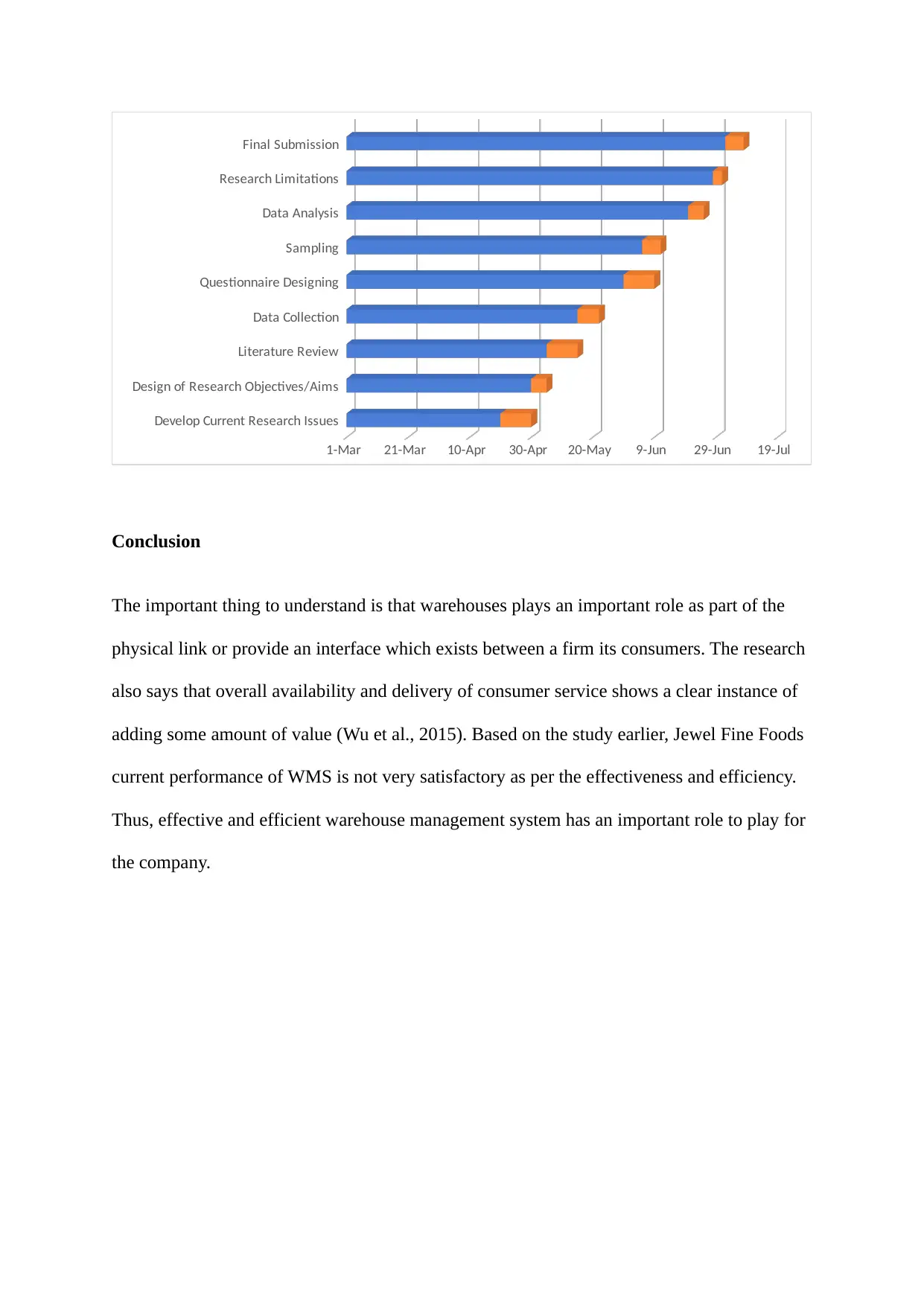
Develop Current Research Issues
Design of Research Objectives/Aims
Literature Review
Data Collection
Questionnaire Designing
Sampling
Data Analysis
Research Limitations
Final Submission
1-Mar 21-Mar 10-Apr 30-Apr 20-May 9-Jun 29-Jun 19-Jul
Conclusion
The important thing to understand is that warehouses plays an important role as part of the
physical link or provide an interface which exists between a firm its consumers. The research
also says that overall availability and delivery of consumer service shows a clear instance of
adding some amount of value (Wu et al., 2015). Based on the study earlier, Jewel Fine Foods
current performance of WMS is not very satisfactory as per the effectiveness and efficiency.
Thus, effective and efficient warehouse management system has an important role to play for
the company.
Design of Research Objectives/Aims
Literature Review
Data Collection
Questionnaire Designing
Sampling
Data Analysis
Research Limitations
Final Submission
1-Mar 21-Mar 10-Apr 30-Apr 20-May 9-Jun 29-Jun 19-Jul
Conclusion
The important thing to understand is that warehouses plays an important role as part of the
physical link or provide an interface which exists between a firm its consumers. The research
also says that overall availability and delivery of consumer service shows a clear instance of
adding some amount of value (Wu et al., 2015). Based on the study earlier, Jewel Fine Foods
current performance of WMS is not very satisfactory as per the effectiveness and efficiency.
Thus, effective and efficient warehouse management system has an important role to play for
the company.
⊘ This is a preview!⊘
Do you want full access?
Subscribe today to unlock all pages.

Trusted by 1+ million students worldwide
1 out of 15
Related Documents
Your All-in-One AI-Powered Toolkit for Academic Success.
+13062052269
info@desklib.com
Available 24*7 on WhatsApp / Email
![[object Object]](/_next/static/media/star-bottom.7253800d.svg)
Unlock your academic potential
Copyright © 2020–2025 A2Z Services. All Rights Reserved. Developed and managed by ZUCOL.





